加拿大石油ATFD3M自动变速箱油-Petro-CanadaLubricants
DEXRON-Ⅲ自动变速箱油
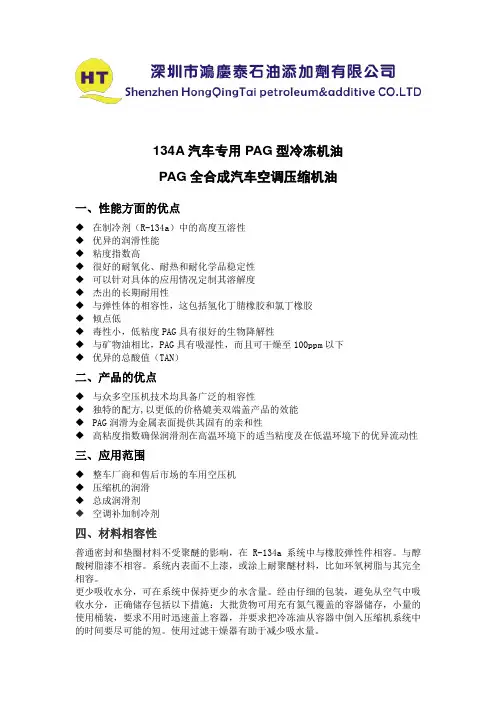
134A汽车专用PAG型冷冻机油PAG全合成汽车空调压缩机油一、性能方面的优点◆在制冷剂(R-134a)中的高度互溶性◆优异的润滑性能◆粘度指数高◆很好的耐氧化、耐热和耐化学品稳定性◆可以针对具体的应用情况定制其溶解度◆杰出的长期耐用性◆与弹性体的相容性,这包括氢化丁腈橡胶和氯丁橡胶◆倾点低◆毒性小,低粘度PAG具有很好的生物降解性◆与矿物油相比,PAG具有吸湿性,而且可干燥至100ppm以下◆优异的总酸值(TAN)二、产品的优点◆与众多空压机技术均具备广泛的相容性◆独特的配方,以更低的价格媲美双端盖产品的效能◆PAG润滑为金属表面提供其固有的亲和性◆高粘度指数确保润滑剂在高温环境下的适当粘度及在低温环境下的优异流动性三、应用范围◆整车厂商和售后市场的车用空压机◆压缩机的润滑◆总成润滑剂◆空调补加制冷剂四、材料相容性普通密封和垫圈材料不受聚醚的影响,在 R-134a系统中与橡胶弹性件相容。
与醇酸树脂漆不相容。
系统内表面不上漆,或涂上耐聚醚材料,比如环氧树脂与其完全相容。
更少吸收水分,可在系统中保持更少的水含量。
经由仔细的包装,避免从空气中吸收水分,正确储存包括以下措施:大批货物可用充有氮气覆盖的容器储存,小量的使用桶装,要求不用时迅速盖上容器,并要求把冷冻油从容器中倒入压缩机系统中的时间要尽可能的短。
使用过滤干燥器有助于减少吸水量。
五、电学性能冷冻油在密封和半密封系统中使用时,可能会直接接触到电机绕线,由此,电学性能诸如:绝缘强度、与电机绕线绝缘层的相容性就很重要。
通过最大限度地减少水含量可以获得好的绝缘性能,对于冷冻压缩机油可通过测量绝缘击穿电压得到含水量的数据。
六、质量规范及典型数据PAG全合成汽车空调压缩机油质量指标七、包装储运本产品在储存、装卸及调油时,参照SH/T0164进行;若长期储存,最高温度不应超过45℃。
本产品不易燃、不易爆、无腐蚀性,使用过程中应遵循处理化学品的一般预防措施。
SINOPEC MTF P-II手动变速箱油(乘用车用)产品说明书
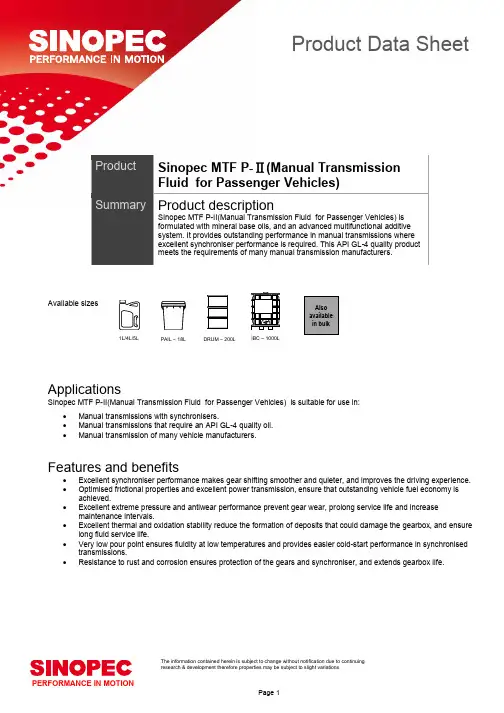
Available sizesApplicationsSinopec MTF P-II(Manual Transmission Fluid for Passenger Vehicles) is suitable for use in:∙ Manual transmissions with synchronisers.∙ Manual transmissions that require an API GL-4 quality oil. ∙Manual transmission of many vehicle manufacturers.Features and benefits∙ Excellent synchroniser performance makes gear shifting smoother and quieter, and improves the driving experience. ∙Optimised frictional properties and excellent power transmission, ensure that outstanding vehicle fuel economy is achieved.∙ Excellent extreme pressure and antiwear performance prevent gear wear, prolong service life and increase maintenance intervals.∙ Excellent thermal and oxidation stability reduce the formation of deposits that could damage the gearbox, and ensure long fluid service life.∙ Very low pour point ensures fluidity at low temperatures and provides easier cold-start performance in synchronised transmissions.∙Resistance to rust and corrosion ensures protection of the gears and synchroniser, and extends gearbox life.1L/4L/5LPAIL – 18LDRUM – 200LIBC – 1000LAccuracy of informationData provided in this PDS is typical and subject to change as a result of continuing product research and development. The information given was correct at the time of printing. The typical values given are subject to variations in the testing procedures and the manufacturing process may also result in slight variations. Sinopec guarantees that its lubricants meet any industry and OEM specifications referred to on this data sheet.Sinopec cannot be held responsible for any deterioration in the product due to incorrect storage or handling. Information on best practice is available from your local distributor.Product and environmental safetyThis product should not cause any health problems when used in the applications suggested and when the guidance provided in the Material Safety Data Sheet (MSDS) is followed. Please consult the MSDS for more detailed advice on handling; MSDSs are available from your local distributor. Do not use the product in applications other than those suggested.As with all products, please take care to avoid environmental contamination when disposing of this product. Used oil should be sent for reclamation/recycling or, if not possible, must be disposed of according to relevant government/authority regulations. The SINOPEC trademark is registered and protected.Issued: March 2017© Sinopec 2017 Sinopec MTF P-II(Manual Transmission Fluid for Passenger Vehicles)。
加拿大石油-车队用油
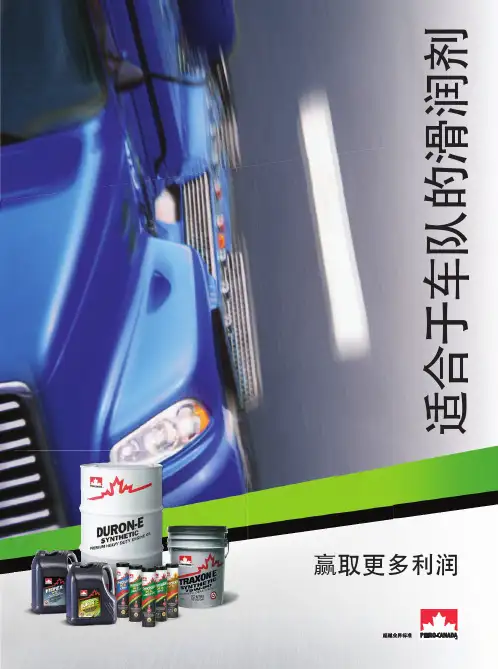
适合于车队的滑润剂
帮助您的车队
超越业界标准
您的卡车要经历长途、艰难跋涉。在夏天,要忍受长时间的 酷热和飞扬的沙尘。而在冬天,则要面对寒冷刺骨的雨、雪 和冰。走走停停,年复一年。
您需要卓越的润滑油来使您的车正常行驶,而不是频繁进出 修理厂。您所选择的润滑油是关键,有可能使您的车正常运 行,也会造成昂贵的停工期。这也是许多车队经理向加拿大 石油公司 (Petro-Canada) 寻找高性能解决方案以提高生产 力并且降低运行成本的原因。此外,我们超先进的润滑油有 助于使您的新车达到最佳行驶性能,还能延长旧设备的生产 寿命。
典型案A例FTER 90-CYCLE K.O. SHEAR TEST (ASTM D6278)
3.0 即LO使WER发IS B动ETTE机R 在运行78,000公里后,DURON-E10W-40合成
2.5
润滑油中的磨痕与新油不相上下。.
2.0
DURON-E5W-40 合成润滑油具有先进的烟炱控制能力,可以 在最寒冷的气候条件下使用。这种润滑油具有优良的冷启动 性能,其低粘性阻力,可以在最恶劣的条件下出色的保护发 动机,优化发动机效率。
1
接下来将介绍我们的解决方案。
我们以优质的服务和行业专业技术著称。但最为人称道的是 我们可节约成本的解决方案。我们帮助您提高贵车队的生产 力。我们的销售和技术支持团队了解汽车运输业,而且装备 精良,可为您提供及时的现场解决方案。这些解决方案能延 长车辆的正常工作时间、降低维护成本,并且为您提供最高 的投资回报率。我们称之为“切实的节约解决方案”。 我们还能做什么?我们会帮助您减少润滑油的使用品种,也为 您提供成本节约模式。只为一个目的:帮助您的车队保持最高 工作效率。选择加拿大石油公司 (Petro-Canada),您将获 得超越业界标准的解决方案。 请向我们索取相关例证材料,了解与您类似的公司是如何使 用我们的高级润滑油来节约资金的。
恒达 Honda 自动变速箱油、手动变速箱油和刹车油使用指南说明书
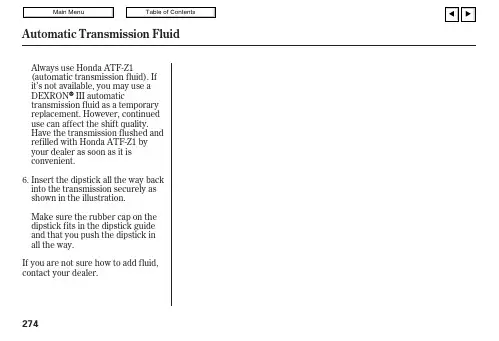
Insert the dipstick all the way back into the transmission securely as shown in the illustration.Always use Honda ATF-Z1(automatic transmission fluid).If it’s not available,you may use a DEXRON III automatictransmission fluid as a temporary replacement.However,continued use can affect the shift quality.Have the transmission flushed and refilled with Honda ATF-Z1by your dealer as soon as it is convenient.Make sure the rubber cap on the dipstick fits in the dipstick guide and that you push the dipstick in all the way.If you are not sure how toadd fluid,contact your dealer.6.Automatic Transmission Fluid2744WD model onlyBrake fluid marked DOT 5is not compatible with your vehicle’s braking system and can cause extensive damage.Using any non-Honda brake fluid can cause corrosion and decrease the life of the system.Have the brake system flushed and refilled with Honda Heavy Duty Brake Fluid DOT 3as soon as possible.Always use Honda Heavy Duty Brake Fluid DOT 3.If it is notavailable,you should use only DOT 3or DOT 4fluid,from a sealed container,as a temporary replacement.The rear differential should be drained and refilled with new fluid according to the maintenancemessages shown on the information display.Have your dealer replace the rear differential fluid.Replace the brake fluid according to the maintenance messages shown on the information display.The fluid level should be between the MIN and MAX marks on the side of the reservoir.If the level is at or below the MIN mark,your brake system needs attention.Have the brake system inspected for leaks or worn brake pads.Check the fluid level in the brake fluid reservoir monthly.Use Honda Dual Pump Fluid only.Do not use automatic transmission fluid (ATF).Rear Differential FluidBrake FluidRear Differential Fluid,Brake FluidMaintenance275Check the level on the side of the reservoir when the engine is cold.The fluid should be between theUPPER LEVEL and LOWER LEVEL.If not,add power steering fluid to the UPPER LEVEL.Pour the fluid slowly and carefully so you do not spill any.Clean up any spills immediately;it could damage components in the engine compartment.Power Steering Fluid276CONTINUEDThe headlights were properly aimed when your vehicle was new.If you regularly carry heavy items in the cargo area or pull a trailer,readjustment may be required.Adjustments should be done by your dealer or other qualified technician.Open the hood.To change the headlight bulb on the driver’s side,remove theunder-hood fuse box from its stay by pulling it out of its stay.1.Headlight AimingLightsMaintenance277Remove the electrical connector from the bulb by pulling the connector straight back.Remove the rubber weather seal by pulling on the tab.Unclip the end of the hold-down wire from its slot.Pivot it out of the way,and remove the bulb.Install the new bulb into the hole,making sure the tabs are in their slots.Pivot the hold-down wire back in place,and clip the end into the slot.Install the rubber seal over the back of the headlight assembly.Make sure one of the three arrows on the rubber seal is facing up;it is marked ‘‘.’’Push the electrical connector onto the new bulb.Make sure it is connected securely.Turn on the headlights to test the new bulb.(Driver’s side)Reinstall the under-hood fuse box.4.2.3.5.6.7.8.Lights278Insert the socket back into theheadlight assembly.Turn itclockwise to lock it in place.Turn on the lights to make surethe new bulb is working.(Driver’s side)Reinstall the coolant reserve tank.Open the hood.To change the turn signal bulb onthe driver’s side,remove theengine coolant reserve tank bypulling it out of its holder.1.4.5.6.LightsReplacing a Front Turn SignalLight BulbMaintenance279。
加拿大汽油标号 -回复
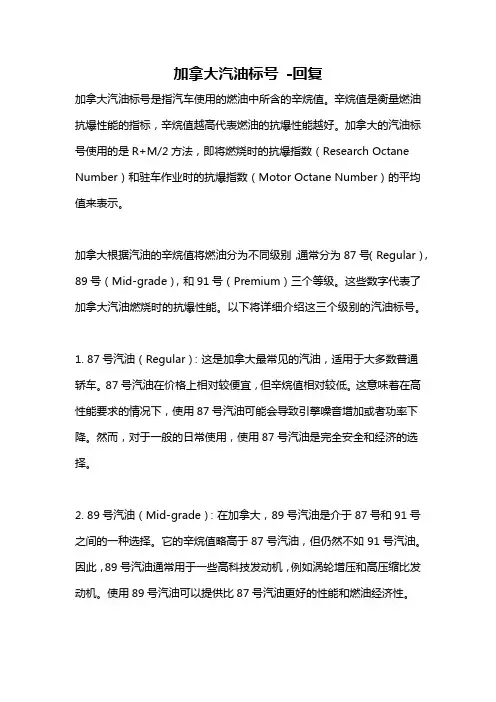
加拿大汽油标号-回复加拿大汽油标号是指汽车使用的燃油中所含的辛烷值。
辛烷值是衡量燃油抗爆性能的指标,辛烷值越高代表燃油的抗爆性能越好。
加拿大的汽油标号使用的是R+M/2方法,即将燃烧时的抗爆指数(Research Octane Number)和驻车作业时的抗爆指数(Motor Octane Number)的平均值来表示。
加拿大根据汽油的辛烷值将燃油分为不同级别,通常分为87号(Regular),89号(Mid-grade),和91号(Premium)三个等级。
这些数字代表了加拿大汽油燃烧时的抗爆性能。
以下将详细介绍这三个级别的汽油标号。
1. 87号汽油(Regular):这是加拿大最常见的汽油,适用于大多数普通轿车。
87号汽油在价格上相对较便宜,但辛烷值相对较低。
这意味着在高性能要求的情况下,使用87号汽油可能会导致引擎噪音增加或者功率下降。
然而,对于一般的日常使用,使用87号汽油是完全安全和经济的选择。
2. 89号汽油(Mid-grade):在加拿大,89号汽油是介于87号和91号之间的一种选择。
它的辛烷值略高于87号汽油,但仍然不如91号汽油。
因此,89号汽油通常用于一些高科技发动机,例如涡轮增压和高压缩比发动机。
使用89号汽油可以提供比87号汽油更好的性能和燃油经济性。
3. 91号汽油(Premium):91号汽油是最高级别的汽油,也是辛烷值最高的选择。
它适用于高性能车辆和一些需要更高辛烷值的特殊引擎,例如豪华汽车和跑车。
使用91号汽油可以提供最佳的性能和燃油经济性,但也是最昂贵的选择。
需要注意的是,虽然汽油标号在辛烷值上有所区别,但它们在其他方面的成分基本相同。
这意味着车辆可以在不同标号的汽油之间自由切换,而不会对引擎产生负面影响。
然而,如果汽车制造商明确指定使用特定汽油标号,为了确保最佳性能和经济性,最好按照建议使用。
此外,加拿大还有一种汽油标号为94号(Ultra 94)。
这是一种特殊级别的高性能汽油,适用于一些高性能和赛车车辆。
各车系变速箱油揭秘
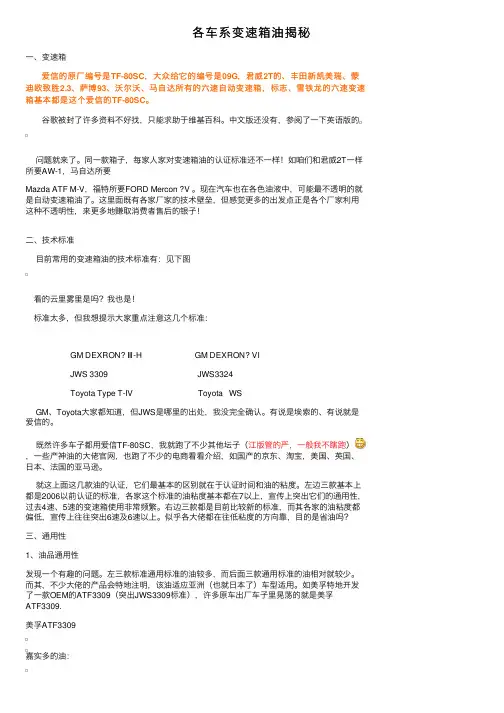
)2.4排量⽤的是东岳的箱⼦。
在变速的同学也很头疼),后者规定使⽤的答案了,它有全车型的符合性选项!可惜法国车早就退出美国了,在法国车型对标中只有什么的古董车型!法国亚马逊也印证了福斯泰坦的说法摩特的ATF-1A(这⼀款有疑问!)特地看了摩特的法国官⽹,发现法国⼈⼀如既往的散漫,就⼀句说明想糊弄⼤伙!不过在君威论坛上貌似看到⼀位车友有关于摩特ATF(注意不是ATF-1)有AW-1的认证!最⽞妙的来了。
redline D6红线特地注明了AW-1-JWS3324的标准!这就是我想寻找的,低粘度版本的AW-1!它区别与过往爱信华纳的JWS3309。
⽆独有偶,我回看安索的低粘度全合成油的认证时也发现了JWS3324!当然同时符合这两个认证条件的油品中,绝不会漏掉toyota WS标准。
再仔细查看,福斯泰坦的ATF4400,它虽然标有AW-1但它是仅标明JWS3309和Toyota Type T-IV。
结合它较为低廉的售价,所以可以判定这是⼀款粘度偏⾼的半合成油品。
经过上述的⼀番折腾,我脑海⾥的思路逐渐清晰。
现在基本可以判定所谓AW-1认证(全名AISIN WARNER-1)就是等同于JWS3324或者toyota WS。
各款产品的参数表格,我就不发了。
反正也看不懂这差零点⼏的区别,我们⽼百姓不是专业⼈⼠,我们应该只看认证!这两天的功课,向坛⼦⾥汇报。
谬误可能颇多,请各位车友斧正!我相信真理总是越辩越明!=====================================================================最新更新找到⼀张AFW+包装上的⼀张认证帖⼦。
上⾯正像我臆测的⼀样,同⽼款AFW⼀样没有所谓的AW-1认证。
那没有AW-1认证,它凭什么能好好的加在雪铁龙C5车⼦⾥呢?所以这更坚定了⾃⼰的想法所谓的AW-1有两个版本(甚⾄以前压根就没有叫AW-1,AW-1是06年以后低黏度油研发出来以后的认证)。
Mercon ULV自动变速箱油产品说明说明书
SAFETY DATA SHEET1. IdentificationMERCON ULV AUTOMATIC TRANSMISSION FLUIDProduct identifierOther means of identification196825FIR No.Automatic Transmission FluidRecommended useNone known.Recommended restrictionsManufacturer/Importer/Supplier/Distributor informationFord Motor CompanyCompany NameAttention: SDS Information, P.O. Box 1899AddressDearborn, Michigan 48121USA1-800-392-3673Telephone1-800-448-2063 (USA and Canada)SDS InformationEmergency telephonenumbersPoison Control Center: USA and Canada: 1-800-959-3673INFOTRAC (Transportation): USA and Canada 1-800-535-50532. Hazard(s) identificationNot classified.Physical hazardsAspiration hazardCategory 1Health hazardsNot classified.Environmental hazardsNot classified.OSHA defined hazardsLabel elementsSignal word DangerHazard statement May be fatal if swallowed and enters airways.Precautionary statementPrevention Observe good industrial hygiene practices.Response If swallowed: Immediately call a poison center/doctor. Do NOT induce vomiting. Take offcontaminated clothing and wash it before reuse.Storage Store locked up.Disposal Dispose of contents/container in accordance with local/regional/national/international regulations. Hazard(s) not otherwiseNone known.classified (HNOC)Supplemental information None.3. Composition/information on ingredientsMixturesCAS number% Chemical name Common name and synonyms89 - 90Distillates (petroleum), hydrotreated64742-55-8light paraffinicSpecific chemical identity and/or exact percentage (concentration) of composition has been withheld as a trade secret.4. First-aid measuresMove to fresh air. Call a physician if symptoms develop or persist.Inhalation Wash off with soap and water. Get medical attention if irritation develops and persists.Skin contact Rinse with water. Get medical attention if irritation develops and persists.Eye contact Call a physician or poison control center immediately. Rinse mouth. Do not induce vomiting. If vomiting occurs, keep head low so that stomach content doesn't get into the lungs.IngestionAspiration may cause pulmonary edema and pneumonitis.Most importantsymptoms/effects, acute and delayedProvide general supportive measures and treat symptomatically. Keep victim under observation.Symptoms may be delayed.Indication of immediatemedical attention and special treatment needed Ensure that medical personnel are aware of the material(s) involved, and take precautions to protect themselves.General information5. Fire-fighting measuresWater fog. Foam. Dry chemical powder. Carbon dioxide (CO2).Suitable extinguishing media Do not use water jet as an extinguisher, as this will spread the fire.Unsuitable extinguishing mediaDuring fire, gases hazardous to health may be formed. Upon decomposition, this product emits carbon monoxide, carbon dioxide and/or low molecular weight hydrocarbons.Specific hazards arising from the chemicalSelf-contained breathing apparatus and full protective clothing must be worn in case of fire.Special protective equipment and precautions for firefighters Move containers from fire area if you can do so without risk.Fire fightingequipment/instructions Use standard firefighting procedures and consider the hazards of other involved materials.Specific methods No unusual fire or explosion hazards noted.General fire hazards6. Accidental release measuresAvoid contact with eyes, skin, and clothing. Avoid inhalation of vapors and spray mists. Ensure adequate ventilation. Keep people away from and upwind of spill/leak. Keep unnecessarypersonnel away. Local authorities should be advised if significant spillages cannot be contained.Wear appropriate protective equipment and clothing during clean-up. For personal protection, see section 8 of the SDS.Personal precautions,protective equipment and emergency proceduresThe product is immiscible with water and will spread on the water surface.Large Spills: Stop the flow of material, if this is without risk. Dike the spilled material, where this is possible. Absorb in vermiculite, dry sand or earth and place into containers. Following product recovery, flush area with water.Small Spills: Wipe up with absorbent material (e.g. cloth, fleece). Clean surface thoroughly to remove residual contamination.Never return spills to original containers for re-use. For waste disposal, see section 13 of the SDS.Methods and materials for containment and cleaning upAvoid discharge into drains, water courses or onto the ground.Environmental precautions7. Handling and storageAvoid contact with eyes, skin, and clothing. Avoid breathing mist or vapor. Avoid prolongedexposure. Provide adequate ventilation. Observe good industrial hygiene practices. Wash hands thoroughly after handling. Wear appropriate personal protective equipment. For personal protection, see Section 8 of the SDS.Precautions for safe handlingStore locked up. Store in tightly closed container. Store away from incompatible materials (see Section 10 of the SDS).Conditions for safe storage,including any incompatibilities8. Exposure controls/personal protectionOccupational exposure limitsThe following constituents are the only constituents of the product which have a PEL, TLV or other recommended exposure limit.At this time, the other constituents have no known exposure limits.US. OSHA Table Z-1 Limits for Air Contaminants (29 CFR 1910.1000)Form Value Components Type PEL5 mg/m3Mist.Distillates (petroleum),hydrotreated light paraffinic (CAS 64742-55-8)US. ACGIH Threshold Limit Values FormValue ComponentsType TWA5 mg/m3Inhalable fraction.Distillates (petroleum),hydrotreated light paraffinic (CAS 64742-55-8)US. NIOSH: Pocket Guide to Chemical Hazards Form Value Components Type STEL10 mg/m3Mist.Distillates (petroleum),hydrotreated light paraffinic (CAS 64742-55-8)TWA 5 mg/m3Mist.No biological exposure limits noted for the ingredient(s).Biological limit values Use adequate ventilation to control airborne concentrations below the exposure limits/guidelines. If user operations generate a vapor, dust and/or mist, use process enclosure, appropriate local exhaust ventilation, or other engineering controls to control airborne levels below the recommended exposure limits/guidelines.Appropriate engineering controlsIndividual protection measures, such as personal protective equipmentWear safety glasses with side shields (or goggles).Eye/face protectionSkin protectionSuitable chemical protective gloves should be worn when the potential exists for skin exposure.The choice of an appropriate glove does not only depend on its material but also on other quality features and is different from one producer to the other. Nitrile gloves are recommended.Hand protectionWear appropriate chemical resistant clothing if applicable.OtherIf engineering controls do not maintain airborne concentrations to a level which is adequate to protect worker health, an approved respirator must be worn. Respirator selection, use and maintenance should be in accordance with the requirements of OSHA Respiratory Protection Standard 29 CFR 1910.134 and/or Canadian Standard CSA Z94.4.Respiratory protectionWear appropriate thermal protective clothing, when necessary.Thermal hazards Always observe good personal hygiene measures, such as washing after handling the material and before eating, drinking, and/or smoking. Routinely wash work clothing and protective equipment to remove contaminants.General hygiene considerations9. Physical and chemical propertiesAppearanceLiquid.Physical state Liquid.Form Red.Color PETROLEUM OdorOdor threshold Not available.pHNot available.Melting point/freezing point Not available.Initial boiling point and boiling range Not available.Flash point > 314.6 °F (> 157.0 °C) Pensky-Martens Closed Cup Evaporation rate Not available.Not applicable.Flammability (solid, gas)Upper/lower flammability or explosive limits Explosive limit - lower (%)Not available.Explosive limit - upper (%)Not available.Vapor pressure< 1 mm HgVapor density > 1 (Air=1)Relative density0.83 - 0.85 (Water=1)Relative density temperature 60.08 °F (15.6 °C)Solubility(ies)Solubility (water)Negligible Partition coefficient (n-octanol/water)Not available.Auto-ignition temperature Not available.Decomposition temperature Not available.Viscosity19 - 20 cSt Viscosity temperature104 °F (40 °C)10. Stability and reactivityThe product is stable and non-reactive under normal conditions of use, storage and transport.Reactivity Material is stable under normal conditions.Chemical stability No dangerous reaction known under conditions of normal use.Possibility of hazardous reactionsContact with incompatible materials.Conditions to avoid Strong oxidizing agents.Incompatible materials Upon decomposition, this product emits carbon monoxide, carbon dioxide and/or low molecular weight hydrocarbons.Hazardous decomposition products11. Toxicological informationInformation on likely routes of exposureInhalationBased on available data, the classification criteria are not met. Prolonged inhalation may be harmful.Skin contact Based on available data, the classification criteria are not met.Eye contact Based on available data, the classification criteria are not met.IngestionDroplets of the product aspirated into the lungs through ingestion or vomiting may cause a serious chemical pneumonia.Symptoms related to the physical, chemical andtoxicological characteristics Aspiration may cause pulmonary edema and pneumonitis.Information on toxicological effectsAcute toxicityMay be fatal if swallowed and enters airways.Prolonged skin contact may cause temporary irritation.Skin corrosion/irritation Direct contact with eyes may cause temporary irritation.Serious eye damage/eye irritationRespiratory or skin sensitizationRespiratory sensitizationNot a respiratory sensitizer.This product is not expected to cause skin sensitization.Skin sensitization No data available to indicate product or any components present at greater than 0.1% are mutagenic or genotoxic.Germ cell mutagenicity CarcinogenicityNot classifiable as to carcinogenicity to humans.IARC Monographs. Overall Evaluation of CarcinogenicityNot listed.OSHA Specifically Regulated Substances (29 CFR 1910.1001-1053)Not listed.This product is not expected to cause reproductive or developmental effects.Reproductive toxicitySpecific target organ toxicity -single exposureNot classified.Specific target organ toxicity -repeated exposureNot classified.Aspiration hazard May be fatal if swallowed and enters airways.Chronic effectsProlonged inhalation may be harmful.12. Ecological informationThe product is not classified as environmentally hazardous. However, this does not exclude the possibility that large or frequent spills can have a harmful or damaging effect on the environment.EcotoxicityNo data is available on the degradability of any ingredients in the mixture. Persistence and degradabilityBioaccumulative potential No data available.Mobility in soil Other adverse effectsNo other adverse environmental effects (e.g. ozone depletion, photochemical ozone creationpotential, endocrine disruption, global warming potential) are expected from this component.13. Disposal considerationsCollect and reclaim or dispose in sealed containers at licensed waste disposal site. Dispose of contents/container in accordance with local/regional/national/international regulations. Don't pollute. Conserve resources. Return used oil to collection centers.Disposal instructionsDispose in accordance with all applicable regulations.Local disposal regulations The waste code should be assigned in discussion between the user, the producer and the waste disposal company.Hazardous waste code Dispose of in accordance with local regulations. Empty containers or liners may retain some product residues. This material and its container must be disposed of in a safe manner (see:Disposal instructions).Waste from residues / unused productsSince emptied containers may retain product residue, follow label warnings even after container is emptied. Empty containers should be taken to an approved waste handling site for recycling or disposal.Contaminated packaging14. Transport informationDOTNot regulated as dangerous goods.IATANot regulated as dangerous goods.IMDGNot regulated as dangerous goods.Not established.Transport in bulk according toAnnex II of MARPOL 73/78 and the IBC Code15. Regulatory informationThis product is a "Hazardous Chemical" as defined by the OSHA Hazard Communication Standard, 29 CFR 1910.1200.US federal regulationsToxic Substances Control Act (TSCA)TSCA Section 12(b) Export Notification (40 CFR 707, Subpt. D)Not regulated.CERCLA Hazardous Substance List (40 CFR 302.4)Not listed.SARA 304 Emergency release notificationNot regulated.OSHA Specifically Regulated Substances (29 CFR 1910.1001-1053)Not listed.SARA 302 Extremely hazardous substanceSuperfund Amendments and Reauthorization Act of 1986 (SARA)Not listed.YesSARA 311/312 Hazardous chemicalAspiration hazardClassified hazard categoriesSARA 313 (TRI reporting)Not regulated.Other federal regulationsClean Air Act (CAA) Section 112 Hazardous Air Pollutants (HAPs) ListNot regulated.Clean Air Act (CAA) Section 112(r) Accidental Release Prevention (40 CFR 68.130)Not regulated.Not regulated.Safe Drinking Water Act(SDWA)International InventoriesAll components are listed or are exempt from listing on the Toxic Substances Control Act Inventory.16. Other information, including date of preparation or last revision08-20-2021Issue date Version 01Health: 0Flammability: 1Physical hazard: 0HMIS® ratingsHealth: 0Flammability: 1Instability: 0NFPA ratingsThis document was prepared by FCSD-Toxicology, Ford Motor Company, Diagnostic Service Center II, 1800 Fairlane Drive, Allen Park, MI 48101, USA, based in part on information provided by the manufacturer. The information on this data sheet represents our current data and is accurate to the best of our knowledge as to the proper handling of this product under normal conditions and in accordance with the application specified on the packaging and/or technical guidance literature. Any other use of the product which involves using the product in combination with any other product or any other process is the responsibility of the user. To the extent that there are any differences between this product’s Safety Data Sheet (SDS) and the consumer packaged product labels, the SDS should be followed.Preparation Information and DisclaimerXT-12-QULV, XT-12-QULV1Part number(s)。
美孚自动变速箱油Mobil ATF D M
级别:DEXRON-VI 容量:946mL/瓶Mobil ATF D/M,是一种高性能,自动变速器液设计以满足服务填补要求,很多车辆的设计,为北美地区。
美孚,亚欧信托基金/提供了可靠的性能,包括顺畅,一致的,所有的天气变化,全能型的润滑保护传动部件。
Mobil ATF D/M,是制定从挑选高品质的基础油再加上一种先进的添加剂系统包括特殊的摩擦改进剂和润滑剂。
它旨在控制转变,从全片式薄膜润滑作为车辆波段和离合器是激活换挡过程。
美孚,亚欧信托基金/确保一致,重复性好,顺利轮班根据一项广泛的驾驶条件下,温度及传送的安全性。
美孚,亚欧信托基金/还可提供抗氧化安定性,即必须符合更严厉的要求,为保证保护在大多数晚期型号的车辆。
主要特点和优点:*优异的热氧化稳定性,为长期和一贯的传输性能。
*优异摩擦改进剂,提高传输效率和转向性能。
*良好剪切强度和抗磨损性能,减少磨损,并保持良好的传输生命。
*优良的低温润滑性能* 优异的热氧化稳定性,为长期和一贯的传输性能*有效控制泡沫性能提供一致的转向性能和减少流体损失严重服务。
*与所有通用密封材料兼容,可帮助控制石油泄漏。
自动变速器,应先检查妥善流体各级定期和流体应该改变,在制造商推荐的间隔。
不过,这可能会因您的汽车的运行条件。
有些制造商建议,更频繁的变化,流体传动受到严厉的驾驶条件,如交通繁忙,炎热的天气和拖车拉。
Specifications and ApprovalsMobil ATF D/M has the following builder approvals:Allison C-4 (C4-31842006) XMobil ATF D/M is recommended forDexron (2005 and earlier) X Caterpillar TO-2 X Ford’s Mercon ATF X Ford ESP-M2C166H X Ford ESP-M2C138CJ X Dexron-VI ATF is preferredTypical PropertiesMobil ATF D/MViscosity cSt @ 40℃35.3 cSt @ 100℃7.4 cSt @ -40℃16,670 Viscosity Index 183 Flash Point, ℃(F) 180 (356) Gravity, API 32 Colour redMobil ATF D/M建议由埃克森美孚,用于在2005年早些时候通用汽车。
ATF用油推荐表
ATF SPIII
现代途胜
DIAMOND ATF SPIII SK 7.8L
40,000km
无
ATF SPIII
上海通用凯越 ESSO LT 71141 或 ISU 6.9L
60,000km
无
上海通用君威
H50235 DEXRON III
60,000km
DEXRON
克莱斯勒 300C 雪佛兰景程 雪佛兰乐风 雪佛兰乐聘 雪佛兰 SPARK 菲亚特西耶耶 菲亚特派力奥 福特福克斯 福特蒙迪欧
40,000km
无
SK ATF SPIII
现代御翔
现 代 正 品 ATF SPIII 2.0/2.4 40,000km
无
DIAMOND ATF SPIII SK 排 量 为
ATF SPIII
7.8L 3.3 排量为
10.9L
现代雅尊
现 代 正 品 ATF SPIII 10.9L
无
DIAMOND ATF SPIII SK
ATF 推荐表
品牌 富康 988 轿车
东 风 雪铁 龙 爱 丽舍 上 海 大众 帕 萨 特
上 海 大众 桑 塔 纳 2000 上 海 大众 桑 塔 纳 3000 一汽大众宝来 一汽奔腾 一汽大众捷达 广州本田雅阁
厂家推荐 AL4 自 动 变 速 器 ESSO LT71171 ESSO LT71141
长 安 福特 嘉 年 华 起亚嘉华 起亚塞拉图
东南菱帅
MOPAR ATF+4
ESSO LT71141, TOTAL
H50235
ISU
DEXTRON
II
EDS-M-8026-B
ISU
DEXTRON
ATF油的介绍
ATF油的介绍自动变速箱用油(Automatic Transmission Fluid),简称ATF。
1.DEXRON标准是根据美国通用汽车公司(GM)的标准来划分的:分为DEXRON I、DEXRON II、DEXRON III等,越往后质量等级越高。
DEXRON标准是应用最广泛的标准,性能要求包括:低温流动性、高温氧化性、抗泡和气体释放性、橡胶密封相容性等。
目前,应用广泛的ATF是DEXRON与DEXRONⅡ和Ⅲ型。
主要应用于美国通用、克莱斯勒,日本和德国的大部分车型上。
福特汽车公司使用的是F型自动变速器油的型号不同,其摩擦因数也不同。
因此,既不能错用,也不能混用。
如果规定使用DexronⅡ型自动变速器油而错用了福特F型自动变速器油,会使自动变速器发生换档冲击和制动器、离合器突然啮合的现象;反之,规定用福特F型自动变速器油而错用了DexronⅡ型自动变速器油,则会出现自动变速器的离合器、制动器打滑,加速摩擦片的早期磨损。
2.ATF的特性由于ATF工作特点的不同,在性能上有别于其它油液,除具有齿轮润滑油的性能外,还应具有液压油的粘度、粘温特性和适合湿式离合器的摩擦特性,主要有以下特性:较高的粘温性:粘度过大过小都会使变速器传动效率下降,而粘度又随温度而变化。
因此,要求ATF低温时粘度不要太大,高温时粘度不能太小。
车用润滑油分类及牌号发布时间:2011-3-258:53:12 浏览次数: 6541、燃机油(1)API质量分级(2)SAE粘度分级(3)燃机油级别牌号的总体表示法及意义如:CD 10W/3030:表示100℃粘度等级为“30”级10W:表示W粘度等级为“10”级(多级油的粘度级别,表示冬夏季通用)CD:表示质量级别,表示柴油机油“D”级依此类推,各类燃机油级别牌号也以此方式表示。
(4)四冲程摩托车机油(简称4T油)的级别牌号4T油分级与汽车用机油相同,如上述表示。
(5)二冲程汽油机油(简称2T油)的分级2T油用法特殊,是与燃料混合使用,并随燃料油一起燃烧的,故2T油为专用油,它有独立的分类标准,如下表:2T摩托车油总的表示方式为:如FC 20,ERB 30,不同的标准用不同的级别符号表示。
- 1、下载文档前请自行甄别文档内容的完整性,平台不提供额外的编辑、内容补充、找答案等附加服务。
- 2、"仅部分预览"的文档,不可在线预览部分如存在完整性等问题,可反馈申请退款(可完整预览的文档不适用该条件!)。
- 3、如文档侵犯您的权益,请联系客服反馈,我们会尽快为您处理(人工客服工作时间:9:00-18:30)。
简介
加拿大石油 ATF D3M 是一种自动变速箱油,具有出色的抗氧化性和热稳定性,使用寿命极长。
加拿大石油 ATF D3M 采用加拿大石油润滑剂公司的 99.9% 高纯度基础油配制而成,这种基础油的生产过程中使用了 HT 提纯工艺和先进的添加剂系统。
加拿大石油 ATF D3M 提供更长的使用寿命,由此缩短维保停机时间并避免高昂的变速器维修费用,从而提高生产率。
特点和优势
• 出色的抗氧化性和热稳定性可延长变速箱油寿命
• 在正常驾驶条件下可持续使用
160,000 km(100,000 英里)
• 延长变速箱的使用寿命
• 提高燃油经济性
• 在低温下保持卓越的流动性
• 在 -40°C / -40°F 的寒冷天气下也能确保车辆顺利启动
• 减少变速箱在寒冷天气下启动时的磨损
• 在低温运行期间实现平稳换挡
• 出众的防磨损保护
• 降低轴承、轴套和齿轮的磨损
• 延长变速箱的使用寿命
• 优化了摩擦性能
• 在整个变速箱油寿命中实现平稳换挡
• 调节液力变矩器时预防离合器颤振
• 离合器片和制动带使用寿命更长应用
建议将加拿大石油 ATF D3M 用于许多老旧汽车和卡车以及非公路车辆上安装的自动、动力换挡和静液压变速箱。
该产品作为汽车设备中的液压油时也能提供出色的性能。
推荐使用满足前通用汽车 DEXRON®-III(H)、-III(G)、-II(E)、-II 或者福特 MERCON®规范的油液时,加拿大石油 ATF D3M 可用于自动变速箱。
这包括旧版通用汽车规范 6297M 和福特规范M2C166-H 或者 M2C185-A。
此外,加拿大石油ATF D3M获得了Allison TES-389 认证,需要应用下列规范时,还可应用 A TF D3M。
• 梅赛德斯奔驰 236.1/.5/.6/.7
• Allison V-730D 和 C-4
• Caterpillar TO-2
• 还可满足 Clark Powershift & Renke 变速箱要求
• 还可应用于液压和动力转向系统。
• 满足英国国防部联合服务名称 OX-75 的要求
推荐使用福特“F型”油或要求符合较近期通用或福特规范的应用不应采用加拿大石油 ATF D3M。
参考汽车用户手册上的具体建议。
是顺科能源公司的商标。
未经许可不得使用。
DEXRON ® 是 General Motors LLC 的注册商标。
MERCON ® 是 Ford Motor Company 的注册商标。
健康与安全
要获取安全数据表 (MSDS),请拨打我们的任一技术数据信息热线。
技术数据信息热线
如果您是想要下订单的现有客户,请致电客户订单管理代表, 号码如下:
系我们:
加拿大 (英语)
............................... 电话:1-800-268-5850 (法语)
............................... 电话:1-800-576-1686美国 .............................................. 电话:
1-877-730-2369拉丁美洲/欧洲/亚洲 ................... 电话:
+1-866-957-4444北美洲1-866-335-3369欧洲 ...................................... +44 (0) 121-781-7264德国 ...................................... 0800-589-4751中国 ...................................... +86 (21) 6362-0066 典型性能数据。
